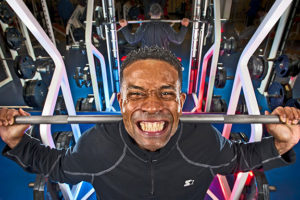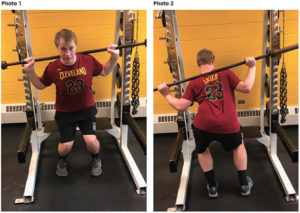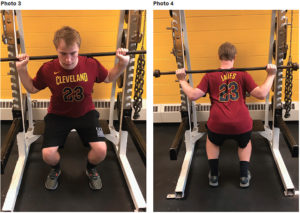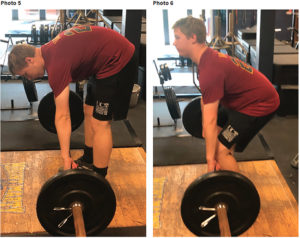Oct 31, 2019Safety in the weight room
Tips to avoid injuries during squats, deadlifts and cleans.

Accidents happen. But there are simple things we can do in the weight room to reduce the risk of injury as much as possible.
First, we should clear up some of the dogma related to strength training. Some believe that having adolescents lift weights increases their risk of injuries, deep squats can damage knees, and deadlifts are bad for the low back. While there’s risk in anything we do, and lifting weights incorrectly can result in injury, evidence doesn’t support these broad assertions. But appropriate strategies must be implemented to maintain safety.
A 2010 literature review by Avery Faigenbaum and Gregory Myer published in the British Journal of Sports Medicine showed several statistics that run counter to these long-held beliefs. In one study, the injury rate per 100 participant hours was 0.0035 for youth resistance training and 0.0017 for weightlifting. By comparison, the injury rate in rugby was 0.8000.
A 2017 epidemiological study of sports-related injuries by Dilip Patel, Ai Yamasaki and Kelly Brown determined that, in 2005, 7.2 million students participated in high school sports. It’s estimated that about two million injuries take place every year in high school sports, with around 30,000 hospitalizations. In their 2016 paper, Yahtyng Sheu and colleagues determined an age-adjusted rate of 34.1 injuries per 1,000 people between 2011 and 2014. The Centers for Disease Control and Prevention estimates the high school sports injury rate at 2.44 injuries per 1,000 athlete exposures.
We need to create competent movers and build strength from a foundation of impeccable form.
Based on current data, sports increase the risk of injury more so than resistance training. However, if resistance training is not properly implemented and monitored, and coaches are not properly trained, there is a risk for injuries in the weight room.
» RELATED: More thoughts on preventing weight room accidents
Unfortunately, many small high schools do not have the resources to fund a full-time strength and conditioning coach. The responsibility often falls on sport or physical education coaches who may not have the necessary background and training. Having a full-time strength coach or sport coach with related training is just as important as having a full-time athletic trainer.
It can be unrealistic to have a full-time strength coach for some schools, but something must be done to ensure more safety in the weight room. I’ve watched numerous videos on social media where there is an incredible amount of unsafe activity taking place in high school and collegiate weight rooms. It needs to stop.
The most common issue is athletes attempting to lift too much weight, often accompanied by a horde of teammates cheering them on. There’s a difference between building mentally tough athletes or camaraderie and putting the athlete in physical danger. Zach Dechant, assistant director of strength and conditioning for Texas Christian University baseball, wrote a book titled “Movement over Maxes,” and I couldn’t agree more with his title’s premise. We need to take a step back from our egos and quit chasing weight room numbers that exceed the capability of our athletes. We can build strong and resilient athletes without putting them in harm’s way under the bar.
Rule No. 1 should always be do no harm. Health drives performance. We need to create competent movers and build strength from a foundation of impeccable form. That’s where a knowledgeable strength coach comes into play. A strong athlete who gets hurt attempting to lift too much does no good for the team. It can end up doing damage that persists long after their athletic career ends.

Here are some important considerations to help reduce the likelihood of injury.
Squats
The squat is a staple of most training programs, and for good reason. But it’s also one of the most botched exercises in the weight room. There is a time and place for quarter and half squats, but not when it’s due to too much weight on the bar. Athletes should first learn and be able to squat through a full range of motion. Only after years of training should they experiment with quarter and half squats.

Two major technique flaws I often see are knee valgus and a shift of the hips to one side (usually the left). A squat should be symmetrical, with knees tracking the midline of the foot or slightly outward. The movement should always be observed by a trained and competent spotter.
The depictions in photo 1 (valgus fault) and photo 2 (hip shift fault) are exaggerated, but they give a good idea of poor squat techniques. Photo 3 (valgus correct) and photo 4 (hip shift correct) show how the movements should be performed.
Deadlift
The deadlift is another movement that should be embedded into the foundation of any strength training program. In recent years, I shifted toward utilizing the hex bar deadlift instead of a traditional straight bar, but both are fine to implement into training programs.

Deadlifts should not utilize a spotter. If an athlete cannot lift the weight, they should decrease it. The biggest technique flaw I see is a rounding of the back. While many top-level powerlifters may do this when attempting maxes, team sport athletes are not competitive powerlifters.
Hips rising before the shoulders is another big flaw, and lifters can often shift their hips as they do during the squat. Photo 5 shows a deadlift with a rounded back flaw. Photo 6 shows the correct position with a neutral spine.
Cleans
I don’t implement clean variations as often as I used to, but they’re still a part of my programming. Olympic lifting takes years of practice to perfect, and there are far too many technique issues to unpack here, but the most common flaw I see has to do with the catch. Far too many athletes catch the bar below their shoulders with excessively flexed wrists, which increases the risk of injury. Many athletes lack the shoulder and wrist mobility to properly catch the clean, as it should be caught on the shoulders, elbows up high, and only a couple of fingers stabilizing the bar.
Another issue I see is people spotting Olympic lifts, which should never require a spotter. The athletes should know how to execute escapes from the bar. In fact, athletes should practice this when learning Olympic lifts.
There are several other technique flaws related to all three lifts. By starting here, strength coaches are on their way to making weight rooms a safe and effective environment.



